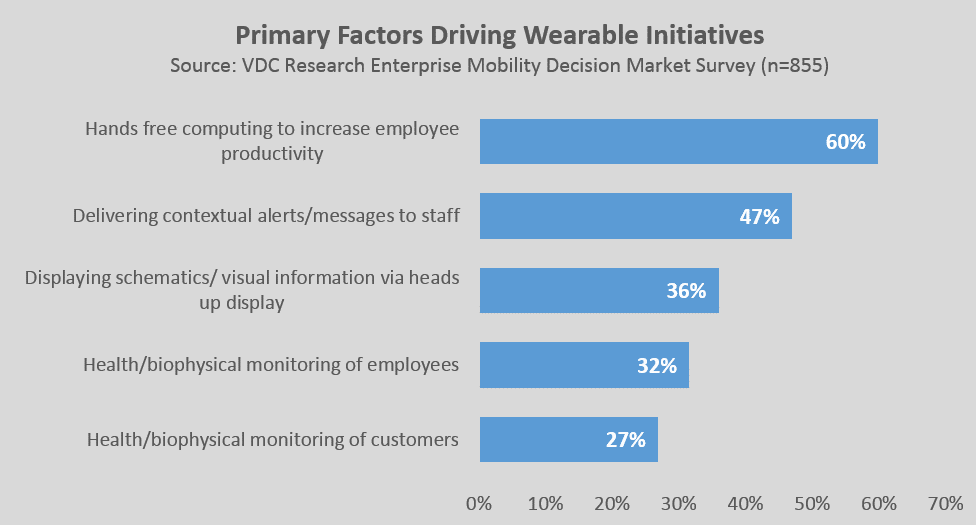Enterprise Mobility & the Connected Worker Blog
RealWear’s HMT-1 Launch Hints at the Opportunity for Industrial Hands Free Computing Solutions
I was recently invited to Keynote RealWear’s launch event for their head-mounted HMT-1 wearable computer to discuss the next wave of enterprise mobile computing and the opportunities for “hands-free” wearable solutions, a market we have been covering at VDC Research for over 10 years.
Anyone familiar with this market know it as one of unfulfilled potential. We have witnessed the comings and goings of many organizations attempting to solve the challenge of a truly immersive wearable experience. The challenge has long been that the technology had never quite caught on to the opportunity. Even with the fanfare around Google Glass – which to its credit drove massive attention towards this category – its limitations around battery life and other functionality shortcomings ultimately lead it also to being marginalized as a viable enterprise solution. However, as we look at the development of several key enabling technologies – including natural language and voice recognition, micro-displays, low power processing, among others – many of the leading roadblocks preventing commercialization are slowly being overcome.
The promise of wearable solutions for enterprise or industrial applications is really about hands free computing for a select group of critical frontline mobile workers. This was confirmed by some research recently conducted by VDC among enterprise mobility decision makers. Spanning warehouse workers and service technicians to delivery drivers and first responders, this target community represents somewhere in the neighborhood of 20-25% of today’s mobile workforce - or approximately 75 million workers in industrialized markets.

The benefits of hands-free computing as that critical “next step” in today’s computing evolution was very much the central theme communicated at this event and RealWear’s unveiling of their HMT-1. RealWear is leveraging the Golden-i reference design from Kopin with whom it has a strategic partnership. The event drew an audience of approximately 200-220 people representing many of RealWear’s launch partners such as PTC, HPE and potential blue chip industrial customers, including BP, Exxon Mobil, Bechtel, Boeing and American Airlines.
RealWear’s CEO, Andy Lowery, put together an impressive executive team made up largely of previous SONIM and Kopin employees. During his presentation a couple of points resonated. One was that the workers targeted with the HMT-1 – while supporting some of the most mission or business critical workflows – are often an afterthought within their businesses when it comes to strategic investment priorities. These workers are often viewed as an “expense” to the businesses they support. As our research has often validated, it is often up to this workforce to ensure that the business and its assets are performing and it is these workers who frequently represent the face of their organizations and one of the few direct points of interaction with customers. Equipping these workers with the right tools to be more productive and deliver better services should make the CIO’s shortlist each year.
So is the HMT-1 the “right tool”? Maybe. While the device is not perfect – battery life when supporting streaming video will be an issue (although having a hot swappable option addresses some of that shortcoming) – it has addressed many of the limitations of other head-mounted wearable solutions. RealWear has worked hard at putting together a strong eco-system of solutions partners which will be critical. Moreover, with wearable solutions, a key success criterion will be a clearly defined use case. This does not mean they need to be single use devices; however, when wearable solutions have done well in the enterprise they have always been connected to a well-defined use case or application (consider, for example, wearable voice solutions used for high volume picking applications). RealWear has identified five core solutions – remote mentoring, document navigation, mobile forms, work instructions and IIoT data visualization – around which it is developing opportunities. They call this “The Last Six Inches for the Connected Industrial Worker”. It will be interesting to track which resonate best.
The timing of the event was good as VDC is about to publish an update to its annual Wearable Computing and Communications Solutions for Line of Business Applications. Please reach out if would like more information about this report.
View the 2017 Enterprise Mobility & Connected Devices Research Outline to learn more.